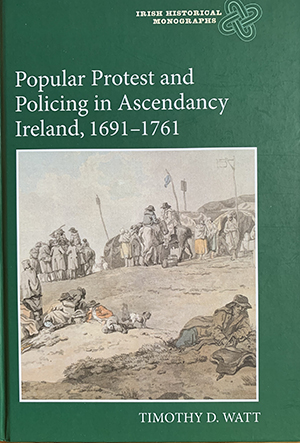POPULAR PROTEST AND POLICING IN ASCENDENCY IRELAND, 1691–1761
Published in Book Reviews, Book Reviews, Issue 4 (July/August 2019), Reviews, Volume 27TIMOTHY D. WATT
Boydell Press, Irish Historical Monographs
£65
ISBN 9781783273126
Reviewed by Myrtle Hill
Myrtle Hill is Visiting Research Fellow at Queen’s University, Belfast.
 As with former publications in the series, this latest monograph sheds light on a previously under-researched aspect of life in Ireland, focusing on our history from a perspective that highlights once more the contradictions and complexities of social interactions. Timothy Watt explains how his interest in the topic was sparked by debates on the riots and the administration of justice that marked the ‘Troubles’ of his upbringing, and his experience has clearly deepened his understanding of how both contemporary and historical events can be subject to multiple interpretations.
As with former publications in the series, this latest monograph sheds light on a previously under-researched aspect of life in Ireland, focusing on our history from a perspective that highlights once more the contradictions and complexities of social interactions. Timothy Watt explains how his interest in the topic was sparked by debates on the riots and the administration of justice that marked the ‘Troubles’ of his upbringing, and his experience has clearly deepened his understanding of how both contemporary and historical events can be subject to multiple interpretations.
The book is in two parts, the first examining the various means of enforcing law and order available to the authorities of the period and the second providing an analysis of the ‘other side’, the collective action taken by the lower orders to protest the actions of those charged with administering justice. Though there is some inevitable overlap in the discussions, this structure enables us to consider theory and practice, actions and reactions, and the relationship between national decisions and local realities.
During this period the State could utilise a range of civil law enforcers, including justices of the peace, revenue officers, the constabulary, watchmen, sheriffs and even intermittently employed ‘posses’ for support in the pursuit, arrest, imprisonment and punishment of wrongdoers. In each of these cases, however, standards varied considerably, with degrees of success often determined by relationships between civil and military law enforcers. Moreover, the forces of the State were unevenly distributed, often ineffective or themselves corrupt. The chapters dealing with these encounters contain local examples of both collective and individual action on either side of the legal system—colourful accounts of crimes, punishments and mob resistance.
The ‘history from below’ provided by the second part of this study points to the wide range of grievances underlying popular protests, from food shortages, poor wages and perceived landlord injustices to new systems of taxation introduced by the State. Local responses to the clamp-down on smuggling, resulting from measures taken to maximise efficiency by the Revenue Commission (‘the largest apparatus of civil administration in eighteenth-century Ireland’), provide particularly noteworthy examples of community action. With smuggling making a lucrative, and sometimes essential, contribution to many family and household economies, dealers and consumers alike felt justified in ‘rescuing’ goods seized by government officials. The threat to small-scale brewers and distillers, both male and female, and the consequent decline in incomes already destabilised by poor harvests both gave a sense of legitimacy to protest and generated crowd support in beleaguered neighbourhoods. This chapter in particular reveals the tensions, contradictions and consequences of the conflicting demands and needs of national and local economies.
Chapter 5 deals with the wider theoretical context, drawing on established historical positions, from E.P. Thompson to S.J. Connolly. The interpretations of collective violence by the Irish lower orders of the period are handled with confidence and the analysis points to a varied though essentially ‘defensive and conservative’ explanation, deeply rooted in local circumstances. Bolstered by new evidence from fresh sources, this nuanced approach offers a significant addition to the existing historiography.
Chapters 7 and 8 turn to urban experiences of collective protest. With their livelihoods threatened by employment laws, low pay and what they regarded as oppressive law enforcement, combinations of journeymen weavers challenged their masters (and, indeed, others, such as women or ‘foreigners’), whom they regarded as impediments to their economic progress. These battles for control of labour by the lower social orders signal the promotion of a working-class culture of self-help at an early stage of its evolution.
Again, however, the State’s ability to tackle such pressure from below was severely hindered by inefficiency and corruption. The most potent of many examples of the latter was in the person of John Hawkins, keeper of Newgate prison and sheriff’s marshall, whose twenty-year career as an instrument of the law was in fact based on extortion, theft and prostitution. While factional gangs and others attempted to challenge such blatant abuses, it took the much slower and more gradual processes of centralisation and modernisation to standardise the system of policing.
In this detailed and ambitious study of ‘complex social phenomena’, the author draws on a wide range of primary and secondary materials from both British and Irish archives and in both languages. These various sources are subjected to careful discourse analysis, lending weight to the author’s interpretations. The broad scope and accumulated detail of the work demand close concentration on the part of the reader, but I would suggest that this volume would be invaluable to students of—and, indeed, all those interested in—the undercurrents of eighteenth-century Irish society.
















